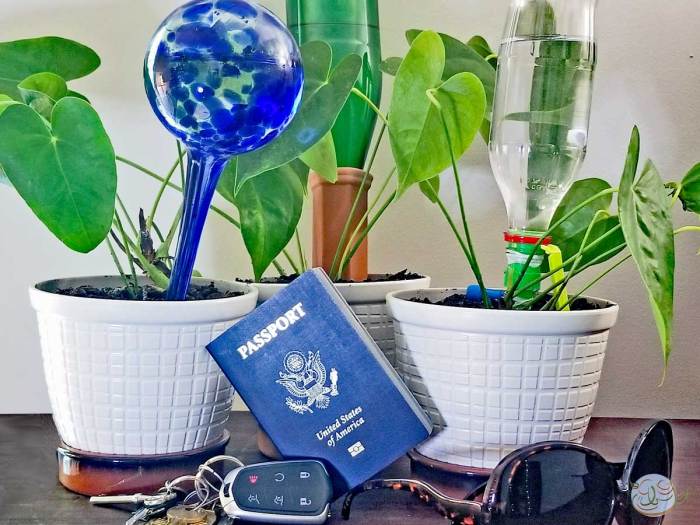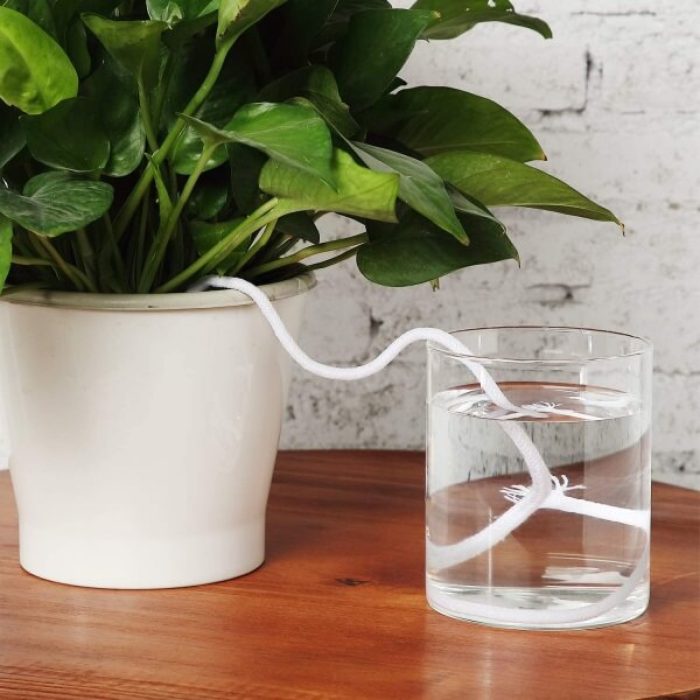How to Water Indoor Plants While on Vacation
Methods for Watering Indoor Plants During Absence
How to water indoor plants while on vacation – Leaving your beloved indoor plants unattended while on vacation can be a source of worry. Fortunately, several self-watering methods can help maintain their hydration. This section explores three popular options: wicking systems, self-watering globes, and watering spikes, comparing their effectiveness and suitability for different plants and pot sizes. We’ll also discuss the reliable, albeit less automated, method of enlisting a friend or neighbor’s help.
Self-Watering Methods: Wicking Systems, Globes, and Spikes
Each self-watering system offers unique advantages and disadvantages. Understanding these differences is crucial for selecting the best option for your plants and vacation length.
| Method | Pros | Cons | Suitability |
|---|---|---|---|
| Wicking System | Provides consistent moisture; suitable for various plant types and pot sizes; relatively inexpensive to set up. | Requires some DIY skills; may not be suitable for all plant types (e.g., those needing very dry conditions); effectiveness depends on the wicking material and pot porosity. | Most indoor plants, especially those with moderate to high watering needs. |
| Self-Watering Globes | Easy to use; requires minimal setup; suitable for smaller pots and individual plants. | Limited water capacity; may not be suitable for large plants or those with high water requirements; globe breakage is a possibility. | Smaller plants with moderate watering needs; ideal for short vacations. |
| Watering Spikes | Easy to insert; suitable for various pot sizes; relatively inexpensive. | Water release rate may not be consistent; can be less effective for larger pots; potential for clogging. | Plants with moderate watering needs; best used in conjunction with other methods for longer absences. |
Manual Watering by a Friend or Neighbor
For peace of mind, particularly with more demanding plants or longer trips, arranging for a trusted friend or neighbor to water your plants manually is highly recommended. A clear and concise watering schedule is essential for this approach.
- Create a detailed list of plants, their watering frequency, and preferred method (e.g., top watering, bottom watering).
- Include photos of each plant to aid identification.
- Provide clear instructions on how much water to use for each plant.
- Specify the exact location of the plants within your home.
- Leave contact information in case of any questions or unforeseen circumstances.
Preparing Plants Before Leaving
Before you embark on your vacation, taking proactive steps to prepare your indoor plants is crucial. This involves assessing soil moisture, adjusting watering methods based on plant type, and grouping plants according to their watering requirements.
Pre-Vacation Plant Preparation: A Step-by-Step Guide
- Assess Soil Moisture: Check the soil moisture level of each plant using your finger. If the top inch feels dry, water thoroughly before leaving.
- Adjust Watering Methods: Reduce the watering frequency for plants that are typically watered frequently (e.g., ferns). For succulents and other drought-tolerant plants, you might need to make minimal adjustments or none at all.
- Group Plants by Watering Needs: This helps you organize your watering schedule for your helper. Group plants with similar watering needs together.
Plant Watering Frequency Guide
- Succulents: Water every 2-3 weeks, or even less frequently depending on the environment.
- Ferns: Water every 1-2 days, depending on the environment.
- Snake Plants: Water every 2-3 weeks, allowing the soil to dry out completely between waterings.
- Orchids: Water when the potting mix is almost dry, usually once a week or less.
- Peace Lilies: Allow the top inch of soil to dry out before watering again, usually once a week.
Choosing the Right Watering System
Selecting the appropriate self-watering system depends on several factors. This section will guide you through the decision-making process, considering plant type, pot size, and vacation duration. A decision tree will help you navigate your options.
Factors to Consider When Choosing a Self-Watering System

Source: eastborngardens.com
The ideal system depends on your specific needs. Consider these factors:
- Plant Type: High-maintenance plants require more frequent and consistent watering than low-maintenance ones.
- Pot Size: Larger pots require more water and may benefit from a more robust system.
- Vacation Duration: Longer trips necessitate systems with greater water capacity.
Decision Tree for Choosing a Watering Method
This decision tree simplifies the process. Begin at the top and follow the arrows based on your answers.
Keeping your indoor plants hydrated while you’re away requires some planning. One option is to use a self-watering system, but if that’s not feasible, consider the plant’s water needs; some, as explained in this article on do plants grow in water , are more tolerant of slightly drier conditions. Understanding this will help you determine the appropriate watering schedule or whether to ask a friend for help while you are away.
- Vacation Length: Less than a week? Use self-watering globes or watering spikes. More than a week? Consider a wicking system or manual watering.
- Plant Type: High-maintenance plants? Manual watering or a wicking system is recommended. Low-maintenance plants? Self-watering globes or spikes may suffice.
- Pot Size: Large pots? Wicking systems are generally best. Small pots? Self-watering globes or spikes are suitable.
Preventing Overwatering or Underwater
Regardless of the chosen method, careful monitoring and adjustment are crucial. For wicking systems, ensure the wick remains unblocked. For globes, monitor water levels and refill as needed. For spikes, check for clogging and replace if necessary. Regularly check the soil moisture levels to avoid extreme conditions.
Addressing Specific Plant Needs

Source: themarketatdelval.com
Different plants have varying water requirements. This section provides guidance on watering specific plant types during extended absences, considering environmental factors like temperature and humidity.
Watering Different Plant Types, How to water indoor plants while on vacation
Adjust watering techniques based on the plant’s natural water requirements and environmental conditions. For example, succulents require less frequent watering than orchids. Higher temperatures and lower humidity will increase the rate of water evaporation, requiring more frequent watering or a larger water reservoir.
Visual Guide to Proper Watering Techniques
Imagine a series of close-up images showcasing proper watering techniques for various plants. One image shows a succulent with its well-draining soil being watered gently from the top, avoiding getting the leaves wet. Another depicts a fern, its potting mix consistently moist but not soggy, being watered carefully from the bottom using a tray method. A third shows an orchid with its specialized potting medium, being watered by gently soaking the medium and allowing for proper drainage.
Troubleshooting and Prevention
Even with careful planning, issues can arise. This section identifies potential problems with self-watering systems and offers solutions. It also highlights common mistakes to avoid.
Potential Problems and Solutions
- Clogged Wicks: Rinse the wick thoroughly with water. Replace if necessary.
- Leaking Watering Globes: Inspect for cracks or damage. Replace if necessary.
- Uneven Watering: Adjust the watering method or system to ensure even moisture distribution.
- Plant Wilting: Check soil moisture and adjust watering accordingly. Ensure proper drainage.
Common Mistakes to Avoid
- Overwatering before leaving: This can lead to root rot.
- Underestimating water needs: Plants can dry out quickly, especially in warm environments.
- Failing to check soil moisture: This can lead to both overwatering and underwatering.
- Using inappropriate watering systems: Choose a system suitable for the plant type and pot size.
General Inquiries: How To Water Indoor Plants While On Vacation
What if my chosen watering method fails?
Have a backup plan! Consider asking a neighbor to check on your plants as a failsafe, or choose a method that allows for easy monitoring remotely if possible.
How often should I check my plants’ soil moisture before leaving?
Check soil moisture 1-2 days before departure to accurately gauge watering needs and adjust your chosen method accordingly.
Can I overwater my plants using a self-watering system?
Yes, even with self-watering systems, it’s possible to overwater. Choose a system appropriate for your plant’s needs and monitor for signs of overwatering like yellowing leaves or soggy soil.
What should I do with plants that need very specific watering schedules?
For plants with highly specific needs, enlisting a friend or neighbor for manual watering is the safest option. Provide detailed instructions and a watering schedule.




















